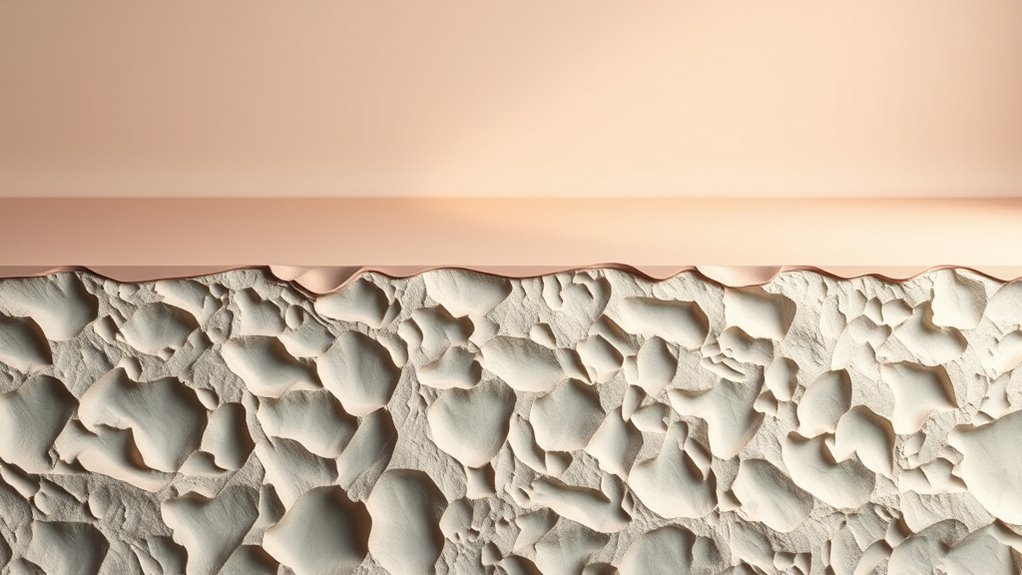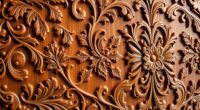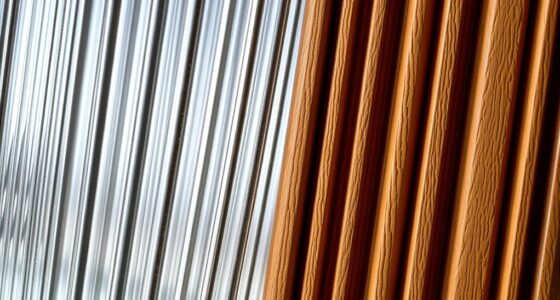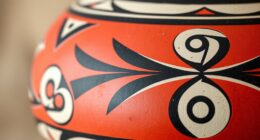Texture gradation guides you to smoothly shift surfaces from smooth to deep reliefs, creating visual and tactile interest. To achieve this, use techniques like blending, layering, and soft tools, while adjusting light and shadow to enhance depth. Selecting the right materials and tools helps craft varied textures, whether digitally or physically. Mastering these methods enhances realism in art and design, and exploring further will deepen your understanding of creating dynamic surface effects.
Key Takeaways
- Achieve smooth to relief textures through gradual blending techniques using tools like sponges, brushes, or digital algorithms.
- Use lighting and shadow manipulation to emphasize surface depth and enhance relief effects visually.
- Apply procedural texturing methods to generate complex, scalable transitions from flat to deeply reliefed surfaces.
- Incorporate material choices and tools such as metallic paints or embossing powders for tactile variation.
- Practice subtle shifts in surface roughness and relief levels to create realistic, seamless texture gradations.
Understanding the Concept of Texture Gradation
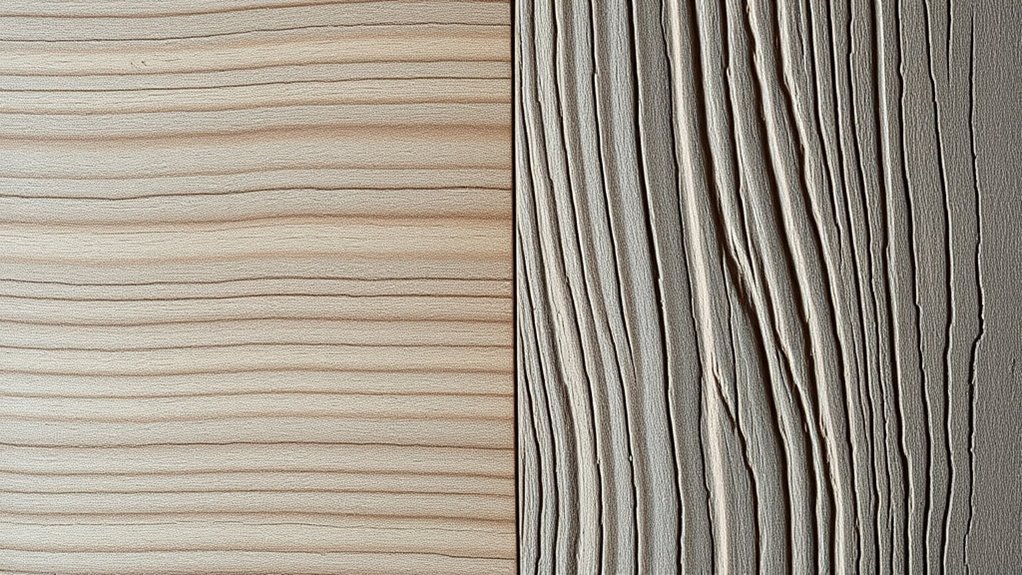
Have you ever noticed how some surfaces shift smoothly from rough to smooth or from dark to light? That’s the essence of texture gradation, which you experience through tactile perception. It’s about understanding how different textures transition seamlessly, creating a sense of depth and complexity. Historically, textures have played a crucial role in art and architecture, helping to evoke emotion or convey status. These historical textures set the foundation for modern techniques, illustrating the gradual change from one surface quality to another. By studying these shifts, you learn to appreciate subtle nuances in materials and surfaces. Texture gradation isn’t just visual; it engages your sense of touch, making you aware of the continuous, dynamic nature of surface qualities in both ancient and contemporary contexts. Additionally, diverse design options in planters demonstrate how texture gradation can enhance aesthetic appeal through tactile and visual variation.
Techniques for Achieving Smooth Transitions in Surface Qualities

Achieving smooth shifts in surface qualities requires deliberate techniques that guide your eye and touch seamlessly from one texture to another. To do this, you manipulate surface tension, creating gradual changes that enhance tactile perception. You can blend textures by gradually decreasing or increasing roughness, avoiding abrupt transitions. Using tools like soft brushes or blending sponges helps soften edges, encouraging fluid gradation. Consider this table for clarity:
| Technique | Effect |
|---|---|
| Gradual blending | Smooth surface transition |
| Soft tools | Reduced edge contrast |
| Layering | Adds depth without harsh boundaries |
Applying these methods ensures your surface qualities flow naturally, engaging viewers through a tactile journey that feels both intentional and harmonious. Understanding how to recognize and address narcissistic traits in interactions can help maintain emotional balance during creative processes.
The Role of Light and Shadow in Enhancing Texture Depth
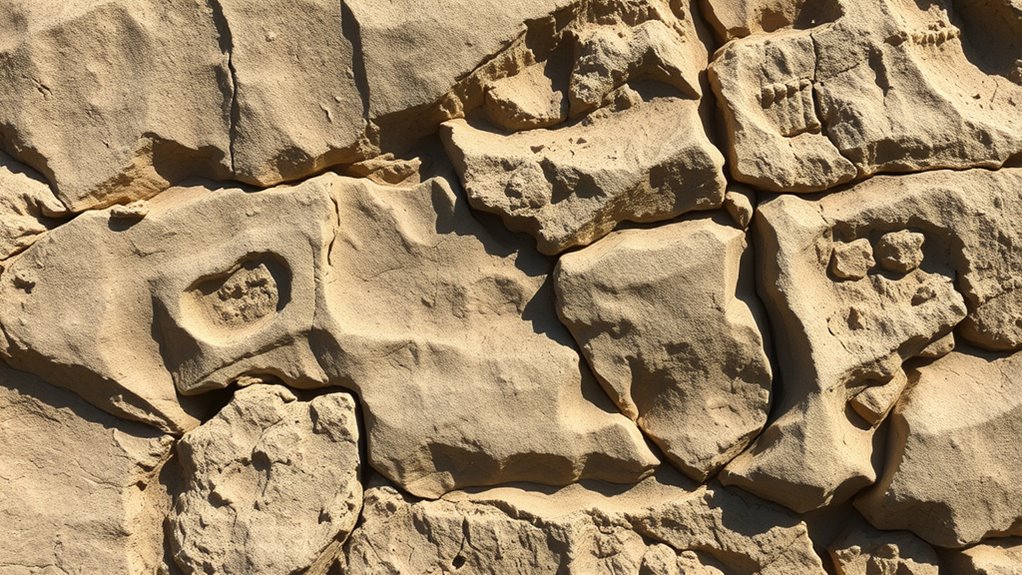
Light and shadow play a crucial role in bringing texture to life by emphasizing surface variations and creating a sense of depth. Using effective illumination techniques, you can highlight the subtle differences in surface relief, making textures more vivid. Shadow manipulation allows you to control how textures appear, enhancing their three-dimensional quality. By adjusting light angles, you can cast shadows that deepen or soften surface details, revealing intricate patterns or smoothing out rough areas. Proper lighting setup accentuates the contrast between illuminated and shaded zones, giving your work a dynamic, tactile feel. Mastering these techniques helps you transform flat surfaces into rich, textured visuals, guiding viewers’ eyes and adding visual interest through expertly crafted light and shadow play. Additionally, understanding color temperature adjustments can fine-tune the overall mood and clarity of your textured surfaces, further enhancing their visual impact.
Materials and Tools for Creating Textural Variations
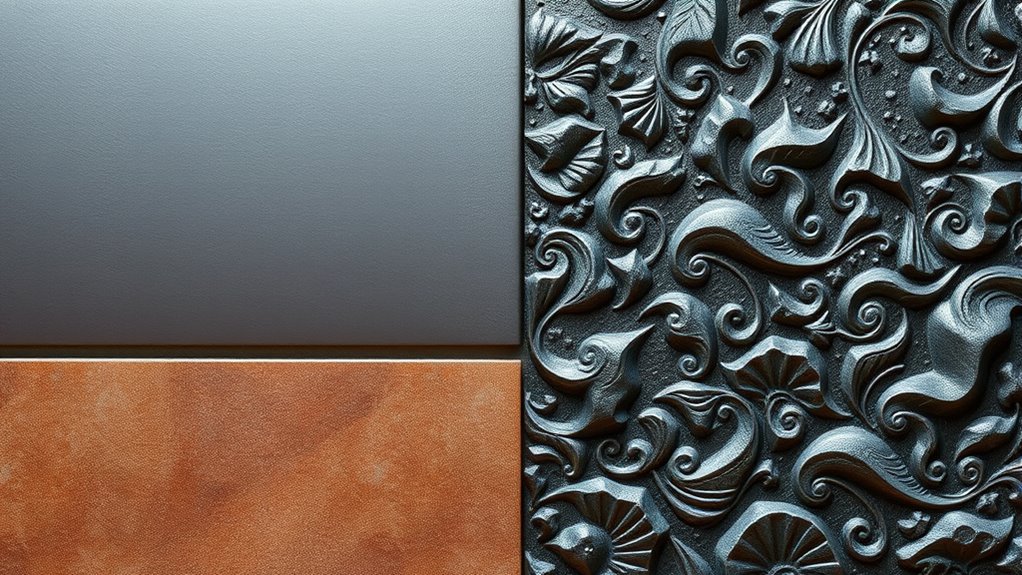
Selecting the right materials and tools is essential for creating effective textural variations. Your choices influence fiber textures and metal finishes, shaping the depth and feel of your work. Use different brushes, palette knives, or sponges to achieve smooth, rough, or deeply reliefed surfaces. Incorporate materials like textured gels, metallic paints, or embossing powders to add dimension. The table below highlights common tools and materials:
| Tool/Material | Texture Type | Best Use |
|---|---|---|
| Palette knives | Deep reliefs | Thick applications, metal finishes |
| Sponges | Soft, subtle textures | Blending fiber textures |
| Metallic paints | Shiny, reflective finishes | Enhancing metal textures |
With these materials, you can experiment to craft varied tactile effects, from smooth to deeply reliefed surfaces.
Applications of Texture Gradation in Fine Art and Design
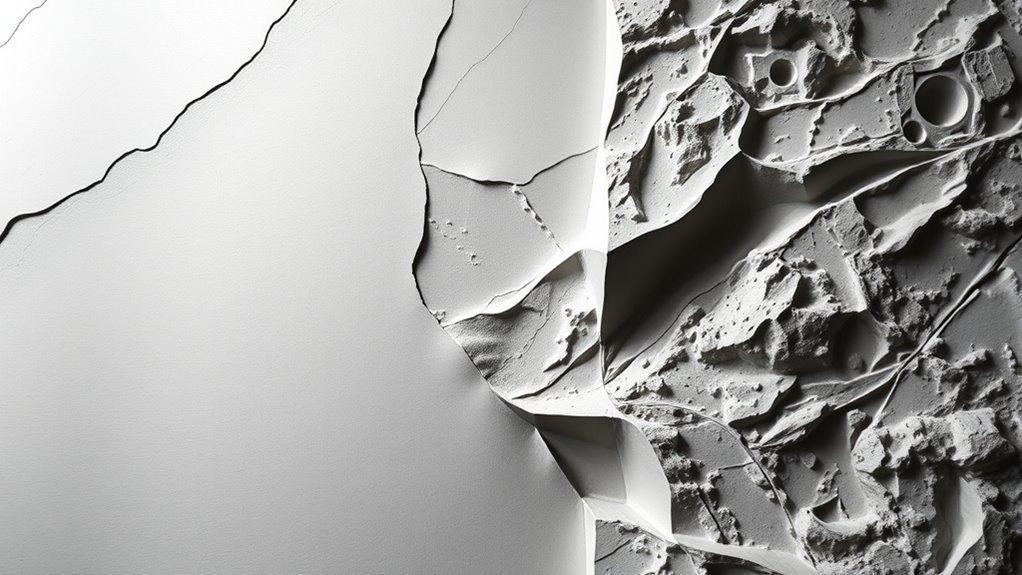
Texture gradation plays a crucial role in enhancing the visual and tactile appeal of both fine art and design projects. Throughout history, its application has evolved through a rich historical evolution, shaping artistic expressions and design trends. Cultural influences considerably impact how texture is used, reflecting unique aesthetic values and symbolic meanings across societies. For example, ancient sculptures relied on deep reliefs to convey depth and importance, while modern art experiments blend smooth and rugged textures to evoke emotion. In contemporary design, texture gradation adds depth, contrast, and sensory engagement, whether in interior spaces, branding, or visual art. Understanding the historical evolution of texture and its roots can deepen appreciation for its diverse applications. By understanding its historical and cultural roots, you can thoughtfully incorporate texture gradation to communicate ideas and evoke specific responses effectively.
Digital Methods for Simulating Surface Gradients
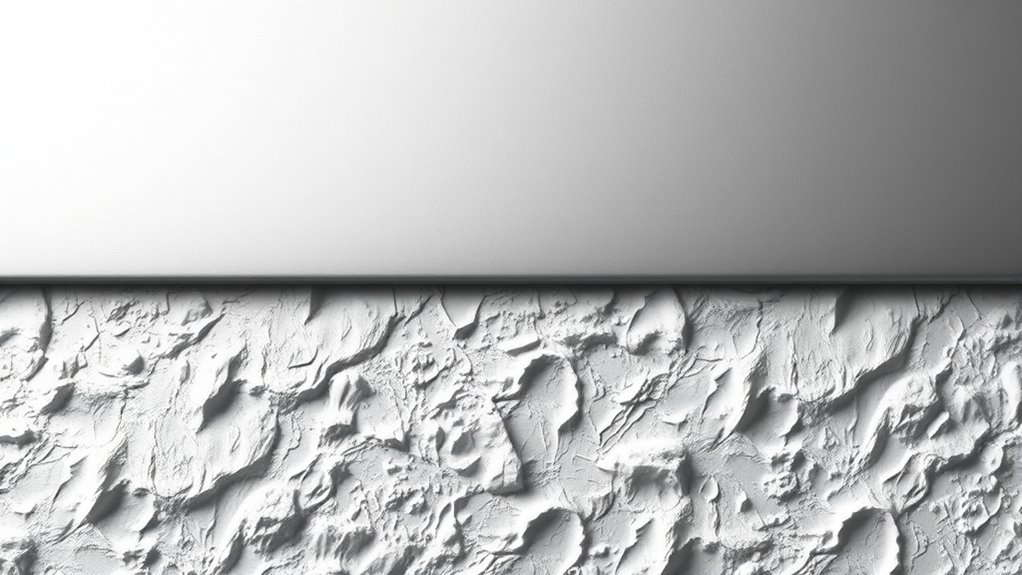
Digital methods offer powerful tools for simulating surface gradients, including gradient mapping techniques that adjust colors smoothly across textures. Procedural texture generation enables you to create complex patterns dynamically, reducing manual effort. Deep relief simulation adds realistic depth to surfaces, enhancing visual richness and tactile impressions. Additionally, understanding battery technologies can inspire innovative approaches to surface texturing by drawing parallels between energy storage and material layering techniques.
Gradient Mapping Techniques
Gradient mapping techniques enable you to create realistic surface gradients by applying digital algorithms that simulate gradual color or tone progressions. You can use these methods to enhance surface polishing, giving your textures a smooth shift from light to dark or vibrant to subdued hues. By carefully selecting and blending multiple color stops, you achieve seamless color blending that mimics natural gradations found in real-world surfaces. These techniques allow precise control over the gradient’s direction, shape, and intensity, making your surface appear more dynamic and lifelike. Whether you’re refining metallic finishes or soft fabric textures, gradient mapping helps you replicate subtle variations in tone that add depth and realism. Mastering these digital methods elevates your surface design, producing visually compelling and richly detailed textures. Additionally, understanding the color transition process can further improve your ability to create convincing and aesthetically pleasing surface gradations.
Procedural Texture Generation
Have you ever wondered how to generate realistic surface gradients automatically? Procedural texture generation uses algorithms like procedural noise to create varied, natural-looking surface patterns without manual input. By adjusting parameters, you can simulate surface deformation, producing textures that mimic natural materials such as stone, wood, or fabric. This method offers high flexibility, allowing you to control scale, detail, and complexity dynamically. Instead of relying on static images or manual painting, procedural techniques generate seamless, repeatable textures that adapt to different surface requirements. With this approach, you can efficiently produce complex gradations from smooth to deeply textured surfaces, making your digital models more realistic and visually engaging. Procedural texture generation empowers you to craft rich, varied surface effects with precision and ease.
Deep Relief Simulation
Deep relief simulation leverages advanced computational techniques to recreate the intricate surface variations found in natural materials. By modeling surface roughness, these methods enhance tactile perception, making digital textures feel more authentic. You can manipulate algorithms to generate deep reliefs that mimic the height variations and complex topographies of real surfaces. These simulations enable precise control over depth, contrast, and texture gradation, resulting in more realistic digital representations. Additionally, understanding retail hours can help optimize access to tools and resources for digital modeling.
Tips for Practicing and Mastering Texture Transition Skills

Mastering texture shift skills requires consistent practice and keen attention to detail. To improve, focus on these key tips:
- Study texture psychology to understand how viewers perceive different textures and how to evoke specific emotions through gradual changes.
- Observe cultural symbolism associated with textures to enhance contextual relevance and deepen the impact of your work.
- Practice blending smooth to deep relief surfaces gradually, paying close attention to subtle shifts that create seamless transitions.
- Incorporate techniques from the Law of Attraction by cultivating positive vibrations to enhance your creative flow and manifest desired artistic outcomes. positive vibrations
Frequently Asked Questions
How Do Texture Gradations Influence Viewer Perception and Emotional Response?
Texture gradations profoundly influence your perception and emotional response by creating tactile engagement and evoking feelings. Smooth textures might make you feel calm or serene, while deep reliefs can evoke excitement or tension. As you experience these gradations, your emotions respond to the visual and tactile cues, allowing the artwork or surface to resonate emotionally and invite you to explore its depth and detail actively.
Can Texture Gradation Techniques Be Applied Effectively in Digital Sculpture?
Yes, you can apply texture gradation techniques effectively in digital sculpting. By using surface detailing tools, you can create smooth shifts and deep reliefs that enhance realism and visual interest. Adjusting brush settings and layering textures allows you to control the depth and subtlety of surface variations. This approach helps evoke emotion and focus viewer attention, making your digital sculpture more dynamic and engaging.
What Cultural Differences Impact the Use of Texture Gradation in Art?
You should consider how cultural symbolism influences texture gradation in art. Different cultures value traditional techniques that emphasize specific textures, like smoothness or deep reliefs, which carry symbolic meanings. For example, some cultures may favor subtle gradations to evoke serenity, while others use bold textures to express strength. Understanding these cultural differences helps you create artwork that resonates deeply, respecting traditional techniques and conveying meaningful symbolism through texture variation.
How Does Scale Affect the Perception of Texture Transitions in Artworks?
Think of scale as a magnifying glass for texture, shaping how you perceive progressions. When artwork is small, subtle gradations create a tactile illusion you almost feel, making textures seem more intimate. Larger pieces magnify these shifts, emphasizing the depth and making the transitions feel more dramatic. Your perception of scale influences whether you interpret textures as gentle or bold, ultimately guiding how you experience the artwork’s tactile story.
Are There Industry Standards for Measuring or Grading Surface Texture Depth?
You’ll find that industry standards for measuring surface texture depth do exist, primarily through surface roughness standards like Ra, Rz, and Rq. These standards help you gauge surface roughness objectively. Texture grading criteria often incorporate these measurements, ensuring consistency across projects. By following these guidelines, you can accurately assess and classify surface textures, ensuring your work meets industry quality benchmarks and communicates the intended tactile or visual effect effectively.
Conclusion
As you explore texture gradation, remember that “practice makes perfect.” Mastering smooth to deep relief shifts takes patience and experimentation. By understanding techniques and harnessing light and shadow, you’ll bring depth and life to your work. Whether working with traditional tools or digital methods, keep pushing your boundaries. With dedication, you’ll transform flat surfaces into engaging, textured masterpieces—proving that art truly is the journey, not just the destination.

